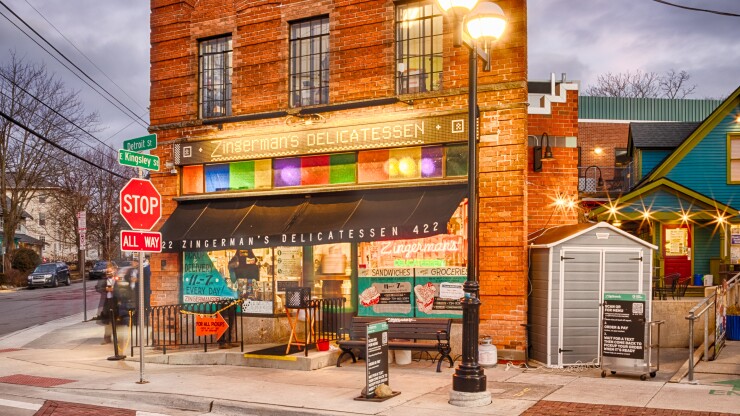The lines used to snake out of Zingerman's Delicatessen, dozens of people waiting around the block, but nobody seemed to care. It was a vital social hub, a place where the queue was more of an attraction than a pain point.
"People didn't complain about the line, they lingered around and we found them to serve their food," said Jennifer Hall, marketing and communication manager at Zingerman's Delicatessen, an expansive red-brick building near the University of Michigan in Ann Arbor. Zingerman's is as familiar to the university community as the Crisler Center basketball arena or the "Big House" football stadium.
A year ago, with scant warning, those lines disappeared and haven't come back. Like thousands of businesses, Zingerman's would have to rebuild its business with digital payments and social distancing at the forefront. Automation would become a business-saving model, more than just a new way to reach new people.
"When everything shut down, we didn't know if it was short-term, six months or a year," Hall said. "We didn't know if we would go back to a model that we had known for decades. We have been here for 39 years."
In the uncertainty, Zingerman's catering business all but disappeared, business from the nearby university hospital staff dried up, and there was no normal graduation, taking away a big crowd of patrons.

With a new spring approaching and variable occupancy guidelines — 25% cap, a quick jump to a 50% cap and a curfew — Zingerman's has for now become a primarily digital business, relying on digital ordering, automated in-app payment processing. These methods are paired with a social tool to encourage the business' community to connect.
Zingerman's has also added a bakery and coffee house, and partnered with about a dozen other small food-focused shops in Ann Arbor to form a loose intellectual property-sharing coalition. Most of these businesses are now fully digital, even with easing pandemic restrictions in Michigan.
"Before the pandemic we would have hundreds of people in and near our patio, while we spotted them and brought their food to them from different parts of our business," Hall said. "There's no way to do that and keep people six feet away from each other."
Take-out and remote ordering were about 10% of Zingerman's business before the pandemic. It's almost all of the business' volume now, save for a few outdoor tables.
Zingerman's added a mobile ordering system about a year before the pandemic hit, and leaned on it during the restrictions of the past year. The system, from Snackpass, includes digital menus, payment apps, in-store self-serve contactless kiosks and incentive marketing with social tools. The deli has also added several delivery apps, building a remote business that did not exist on a large scale earlier; even most of the remote orders were for pickup.
The new system helped Zingerman's retain about 60% of the overall volume it had before the pandemic, as well as manage how many people, including staff, are in its facilities at any given moment. "Sixty percent isn't bad, but it's still more than third less," Hall said.
Zingerman's story mirrors the struggles thousands of
Writing for
While large
"A lot of these smaller restaurants didn't have a website or an app that could drive orders or new business lines," said Benjamin Rubenstein, head of business development and expansion at the San Francisco-based Snackpass, which serves mostly small restaurants, including many in university communities, in an attempt to carve a niche in a market with much larger apps like DoorDash and GrubHub. "Adding a social experience is a way to connect people who have had a harder time finding a community connection that they previously had at a small restaurant."
Even as restrictions are fully lifted and coronavirus vaccines roll out, Zingerman's may not return to the days in which people looked through displays at meats and baked goods, paid at a point of sale terminal and moved to a common area to congregate. A mix of mobile ordering, contactless payments and a reinvention of the store's social experience will persist even with a redesigned in-store layout.
"We've given a lot of thought about how to take people's orders and how we're going to take people's orders and serve them," Hall said. "What was in the past may not come back."





